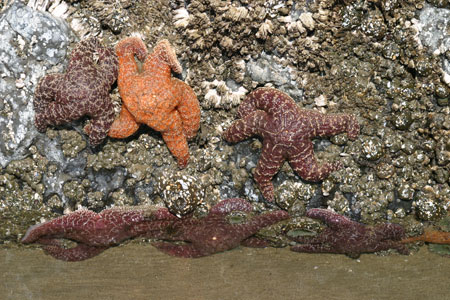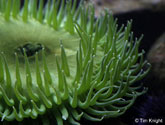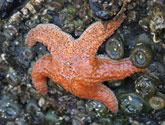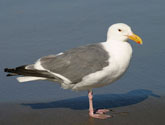
Home |
About Us |
How to Participate |
Biodiversity Modules |
Projects |
Maps |
News |
Resources

Home |
About Us |
How to Participate |
Biodiversity Modules |
Projects |
Maps |
News |
Resources
|
Definition of "Open Water" - General Code 400: Large open water space. Excludes wetlands. |
Open Water: tidal pool (421)
 | Descriptive Habitat Code: Open water habitat (4), salt water tidal pool (21)
Photo: Tidal pool around Haystack Rock at Cannon Beach, Oregon |
 California gull Larus californius Code: LACAL Photo: RA |
Distribution and Habitat: It is found throughout parts of the western North Pacific Ocean. It breeds on gravel beds along the Columbia River and large lakes in the Columbia Basin. Diet: Interesting fact: |
 Green Sea Anemone (uh-NEM-uh-nee) Anthopleura xanthogrammica Photo: TFK |
Distribution and Habitat: The anenome is often found in the shallow intertidal zone. There are more than 1,000 sea anemone species found throughout the world's oceans. Diet: Interesting fact: |
 Mussels Mytilus Photo: TFK |
Distribution and Habitat: Mussels are found in dense mats attached by fine threads to rocks, pilings, or other hard surfaces in the intertidal zone of ocean. Diet: Interesting fact: |
 Sea Cucumber Stichopus californicus Photo: TFK |
Distribution and Habitat: It is found throughout parts of the western North Pacific Ocean. Diet: Interesting fact: |
 Sea star Pisaster ochraceus Photo: TFK |
Distribution and Habitat: It is found throughout parts of the western North Pacific Ocean. Diet: Interesting fact: |
 Western gull Larus occidentalis Code: LAOC Photo: TFK |
Distribution and Habitat: It is found throughout parts of the western North Pacific Ocean. It breeds on gravel beds along the Columbia River and large lakes in the Columbia Basin. Diet: Interesting fact: |
Home |
About Us |
How to Participate |
Biodiversity Modules |
Projects |
Maps |
News |
Resources